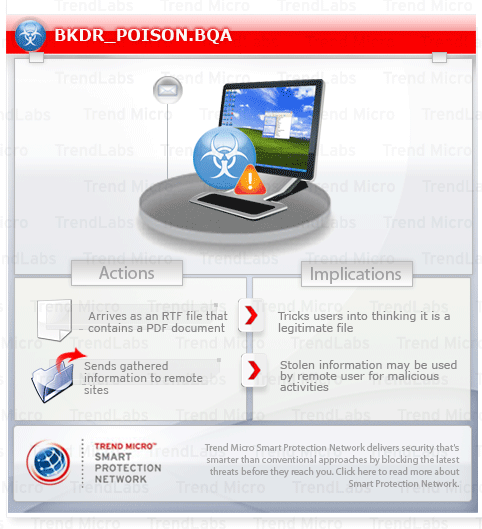BKDR_POISON.BQA
Windows 98, ME, NT, 2000, XP, Server 2003


Threat Type: Backdoor
Destructiveness: No
Encrypted: No
In the wild: Yes
OVERVIEW
This backdoor has received attention from independent media sources and/or other security firms.
To get a one-glance comprehensive view of the behavior of this Backdoor, refer to the Threat Diagram shown below.

This backdoor arrives as an attachment to email messages spammed by other malware/grayware or malicious users.
It opens a hidden Internet Explorer window. It executes a file that contains several commands intended to perform different routines on the affected system.
It deletes itself after execution.
TECHNICAL DETAILS
45,675 bytes
PE
No
06 Jan 2010
Arrival Details
This backdoor arrives as an attachment to email messages spammed by other malware/grayware or malicious users.
Installation
This backdoor drops the following copies of itself into the affected system:
- %System%\senr32.exe
(Note: %System% is the Windows system folder, which is usually C:\Windows\System on Windows 98 and ME, C:\WINNT\System32 on Windows NT and 2000, or C:\Windows\System32 on Windows XP and Server 2003.)
It adds the following mutexes to ensure that only one of its copies runs at any one time:
- )!VoqA.jg
It stays resident in memory by creating the following process(es):
- iexplore.exe
Autostart Technique
This backdoor adds the following registry entries to enable its automatic execution at every system startup:
HKEY_LOCAL_MACHINE\SOFTWARE\Microsoft\
Active Setup\Installed Components\{1E703D92-FC88-919B-8C49-CD2B354F1E44}
StubPath = %System%\senr32.exe
HKEY_LOCAL_MACHINE\SOFTWARE\Microsoft\
Windows\CurrentVersion\Run
System Error Notification = %System%\senr32.exe
Backdoor Routine
This backdoor opens a hidden Internet Explorer window.
It executes a file that contains several commands intended to perform different routines on the affected system.
Other Details
This backdoor deletes itself after execution.
SOLUTION
8.900
6.751.00
06 Jan 2010
6.773.00
11 Jan 2010
Step 1
For Windows XP and Windows Server 2003 users, before doing any scans, please make sure you disable System Restore to allow full scanning of your computer.
Step 2
Restart in Safe Mode
Step 3
Delete this registry key
Important: Editing the Windows Registry incorrectly can lead to irreversible system malfunction. Please do this step only if you know how or you can ask assistance from your system administrator. Else, check this Microsoft article first before modifying your computer's registry.
- In HKEY_LOCAL_MACHINE\SOFTWARE\Microsoft\Active Setup\Installed Components
- {1E703D92-FC88-919B-8C49-CD2B354F1E44}
- {1E703D92-FC88-919B-8C49-CD2B354F1E44}
Step 4
Delete this registry value
Important: Editing the Windows Registry incorrectly can lead to irreversible system malfunction. Please do this step only if you know how or you can ask assistance from your system administrator. Else, check this Microsoft article first before modifying your computer's registry.
- In HKEY_LOCAL_MACHINE\SOFTWARE\Microsoft\Windows\CurrentVersion\Run
- System Error Notification = %System%\senr32.exe
- System Error Notification = %System%\senr32.exe
Step 5
Restart in normal mode and scan your computer with your Trend Micro product for files detected as BKDR_POISON.BQA. If the detected files have already been cleaned, deleted, or quarantined by your Trend Micro product, no further step is required. You may opt to simply delete the quarantined files. Please check this Knowledge Base page for more information.
Step 6
Scan your computer with your Trend Micro product to delete files detected as BKDR_POISON.BQA. If the detected files have already been cleaned, deleted, or quarantined by your Trend Micro product, no further step is required. You may opt to simply delete the quarantined files. Please check this Knowledge Base page for more information.
Did this description help? Tell us how we did.

